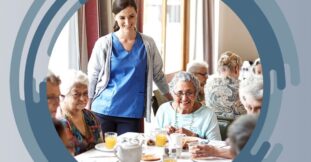7 Reasons to Automate With Senior Care Software
Learn about how senior living point of care software automates resident care documentation and delivers accuracy and efficiency.

Learn about how senior living point of care software automates resident care documentation and delivers accuracy and efficiency.
Published on: April 29, 2021
Last updated: May 22, 2025

Contents
Rising operational costs, pressure to maintain high-quality care, and persistent staffing challenges — if you’re juggling all of these at once, you’re not alone. Senior living leaders across the country are working to strike a better balance between mission and margin, all while navigating workforce shortages and increasing occupancy demands.
Automation through comprehensive senior living software is one way operators are creating space for their teams to work smarter, not harder. While marketing automation may already be part of your toolkit, resident care software offers another powerful opportunity to streamline workflows, improve outcomes, and support staff.
Here’s why more communities are turning to automation to strengthen care and simplify operations.
Consider the sheer amount of staff time currently dedicated to manual documentation and how automation can provide relief:
These tasks represent a significant labor cost by pulling your care team away from residents, ultimately requiring more staff to maintain the same level of care. Automating routine workflows lowers your labor cost per resident, freeing up resources to reinvest in your community.
Preventing compliance violations is the best way to avoid costly fines and protect your reputation, but automation adds an extra layer of protection.
Long-term care automation triggers alerts and workflows for potential risks or incidents, immediately notifying the right care staff and outlining next steps for documentation and follow-up. It can also loop in leadership to ensure visibility.
With Aline Care, data captured during assessments is used to automatically generate care plans and task assignments. Staff can clearly see what’s needed next, helping you meet regulatory requirements and follow internal protocols with confidence.
By automating these processes, care software streamlines senior living operations, elevates care quality, and creates a clear audit trail when you need it most.
Don’t leave incident documentation to chance. Senior living software with natural language processing ensures the person reporting the incident captures vital information consistently and completely.
For example, if a care team member reports a fall, the system intelligently guides them through a standardized set of follow-up questions about location, contributing factors, and immediate response.
Automating the notification process to key stakeholders does more than raise awareness of potential risks. In the event of an investigation, demonstrating proactive efforts to address issues can help show due diligence, potentially reducing legal and financial risk related to resident incidents.
Senior living care software helps you operate more efficiently and reduce expenses while protecting your revenue potential. Key benefits include:
The result: fewer missed charges, smarter resource allocation, and more room in your budget to invest in what matters — from staffing to the amenities that improve daily life for your residents.
Implementing senior living software introduces automated checks and balances throughout the care process, drastically minimizing the potential for human error. This enhanced accuracy directly translates to a safer environment for your residents.
Care software also gives your team real-time access to comprehensive resident data, including vital signs, preferences, and historical trends. This empowers them to anticipate needs and proactively adjust care plans to deliver truly personalized care.
By empowering your team to deliver more precise and attentive care, senior living care software contributes to better resident outcomes and increased peace of mind for your residents’ families.
In high-stress care environments, balancing hands-on resident care with documentation can quickly become overwhelming. This constant juggling often leads to frustration, burnout, and high turnover.
Automation helps ease that burden by streamlining routine tasks and giving care teams more time to focus on what they do best — supporting residents. When staff have tools that simplify their day-to-day responsibilities, they feel more in control, more accomplished, and more valued.
Empowered, efficient staff are more likely to deliver high-quality care and remain with your organization long term, helping you reduce burnout and avoid costly staffing shortages.
Automation surfaces real-time data on everything from care trends to staffing and resource use, eliminating silos and giving you a clear, connected view of your operations.
With access to meaningful insights, you can make smarter decisions about care delivery, staffing, and resource allocation. It also helps you anticipate future needs, identify growth opportunities, and proactively adapt to keep your community strong and sustainable.
Learn more about senior living care software with answers to these common questions.
Senior living care platforms vary widely in capabilities, so it’s important to choose one that meets the unique needs of your community.
Look for the following features:
These features are all part of the larger trend of health care automation designed to improve efficiency and care.
Care software that updates in real time is great until a natural disaster or power outage blocks your internet access. Then, you must opt for care software with offline capabilities, like Aline Care, which allows you to continue tracking care without an internet connection. All records automatically update once the internet connection is restored.
Get a free demo to discover more about how Aline optimizes care for a better experience for staff and residents. We’ll give you a first-hand look at how features like care assessments, task scheduling, and mobile incident reporting can support your community.


Amanda McGrory-Dixon
Amanda McGrory-Dixon is the content marketing manager at Aline, where she shares expert insights on how senior living communities can streamline operations, enhance resident satisfaction, and drive sustainable growth. With a deep understanding of industry trends and technology, she helps operators navigate challenges and implement data-driven strategies to improve efficiency, profitability, and care outcomes.
Blogs, stories and studies from the forefront of senior living operations

Learn how to navigate the complexities of health care payors in senior living for successful revenue management, streamlined operations, and successful…

Boost leads, personalize outreach, automate tasks, and gain data-driven insights with AI solutions

Simplify menu planning in senior living with smart strategies and software that boost efficiency, consistency, and resident satisfaction.

Better care starts with better insights. Learn how senior living teams are using data and technology to create more meaningful resident experiences.

Learn how to improve employee retention in senior living communities and address one of the industry’s biggest staffing challenges.

Disconnected systems hold teams back. Modern senior living financial reporting improves margins, forecasting accuracy, and operational speed.
We’re using cookies on this site to improve your experience. Cookies help us learn how you interact with our website, and remember you when you come back so we can tailor it to your interests.
You can find out more about cookies and usage on our cookie policy page.
Some of these cookies are essential, while others help us to improve your experience by providing insights into how the site is being used.
For more detailed information on the cookies we use, please check our privacy policy
Your experience is important to us. We’re redirecting you to our new Aline website, where you’ll discover how our complete suite of senior living solutions can help you grow occupancy and revenue, optimize operations, and enhance resident care.
For more information, you’re welcome to read our statement on our merger. To continue your web experience, simply close this notification.
Your experience is important to us. We’re redirecting you to our new Aline website, where you’ll discover how our complete suite of senior living solutions can help you grow occupancy and revenue, optimize operations, and enhance resident care.
For more information, you’re welcome to read our statement on our merger. To continue your web experience, simply close this notification.
Your experience is important to us. We’re redirecting you to our new Aline website, where you’ll discover how our complete suite of senior living solutions can help you grow occupancy and revenue, optimize operations, and enhance resident care.
For more information, you’re welcome to read our statement on our merger. To continue your web experience, simply close this notification.
Your experience is important to us. We’re redirecting you to our new Aline website, where you’ll discover how our complete suite of senior living solutions can help you grow occupancy and revenue, optimize operations, and enhance resident care.
For more information, you’re welcome to read our statement on our merger. To continue your web experience, simply close this notification.
2024 Aline Benchmark Report: Your Blueprint for Growth
Discover data-driven insights to maximize occupancy, boost revenue, and optimize performance. Download your free report today.